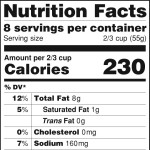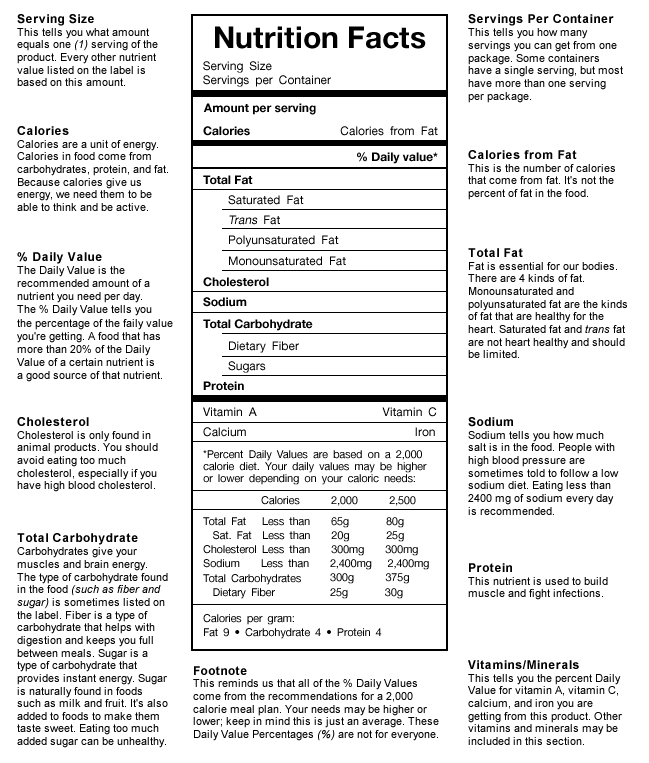 The Nutrition Facts Label tells you what nutrients (components of food your body needs to grow and stay healthy) and how much of those nutrients are found in one serving of the food. The label is found on the outside of most food packages, but isn’t on most fresh foods (such as fruits and vegetables or meats). The Nutrition Facts label can help you make choices about the food you eat.
The Nutrition Facts Label tells you what nutrients (components of food your body needs to grow and stay healthy) and how much of those nutrients are found in one serving of the food. The label is found on the outside of most food packages, but isn’t on most fresh foods (such as fruits and vegetables or meats). The Nutrition Facts label can help you make choices about the food you eat.
What will every Nutrition Facts Label have on it?
The label will have some or all of the following nutrients listed:
- Serving Size: Serving size equals one serving of the product. All the other nutrient values listed on the label are based on this amount.
- Servings per Container: This number is how many servings you can get from one package. Some containers have a single serving, but most have more than one serving per package.
- % Daily Value: This value is the percentage of the recommended daily value for a nutrient that you get in one serving. A food that has more than 20% of the Daily Value of a nutrient is an excellent source; however, for some nutrients such as fat, sodium and cholesterol, the lower the percent, the better.
- Calories (total): Calories are a unit of energy that come from carbohydrates, protein and fat. Calories give us energy so we can think and be active.
- Calories from Fat: This number is the amount of calories that come from fat. It’s not the percent of fat in the food.
- Total Fat: Fat is essential for our bodies. There are 4 kinds of fat. Monounsaturated and polyunsaturated fat are the types of fat that are healthy for the heart.
- Trans Fat: Trans fat is unhealthy for your heart, and should be avoided.
- Cholesterol: Cholesterol is a substance found only in animal products. Eating too much cholesterol is not healthy for your heart.
- Sodium: Sodium is the amount of salt in the serving of food. People with high blood pressure are often told to follow a low sodium diet.
- Total Carbohydrate: Carbohydrates provide your muscles and brain with energy. Certain types of carbohydrates are sometimes listed on the label.
- Dietary Fiber: Dietary fiber helps with digestion and keeps you full between meals.
- Sugars: Sugars are important for instant energy, but eating too much added sugar can be unhealthy. 4 grams of sugar is the same as 1 teaspoon.
- Protein: Protein is used to build muscle and fight infections. It also helps you feel full after you eat.
- Vitamins and Minerals (- A, C, Calcium, Iron): This amount is the percent (%) Daily Value for vitamin A, vitamin C, calcium, and iron you are getting from a serving of this product. Other vitamins and minerals may be included in this section.
Other nutrients, such as polyunsaturated or monounsaturated fat and other vitamins and minerals, can also be put on the Nutrition Facts label if the company that makes the food wants them listed.
What should I look for on the Nutrition Facts Label?
The first thing you should look at is the serving size. The amount of each nutrient listed on the label tells you what is found in one serving of that food, not in the whole container. If you don’t know what one serving size is, you won’t know the amount of each nutrient you’re actually eating. For example, a bag of microwave popcorn has three servings in it. You may want to eat more than one serving at a time, but it’s important to know that if you ate the whole bag, you’d be getting three times what is listed on the label.
Do I need to read every Nutrition Facts Label?
No. You don’t need to keep track of every nutrient you are eating. Just looking at food labels even occasionally can help you choose foods that will give your body the nutrition it needs. For example, if you don’t drink much milk, you should read Nutrition Facts Labels to help you find foods that are high in calcium or vitamin D. You can also use the Nutrition Facts Label to compare 2 different foods. For example, if you are deciding between 2 different kinds of breads, looking at the labels can help you make a healthy choice. Consider choosing the bread that is the highest in fiber.
The food label lists a 2000-calorie diet. Should I be eating 2000 calories?
Probably not. Many adolescents need more than 2000 calories as they grow in height, build bones, build muscles apothekegenerika.de, and stay active. The 2000-calorie diet is just an estimate and is used to help calculate the Percent (%) Daily Value listed on the food label.

The New Nutrition Facts Label is Coming
The Food and Drug Administration (FDA) has updated the Nutrition Facts label. These changes are required by July 26, 2018, but products might have the new label even sooner. Some of the changes being made are:
- Increased font size for calories, serving size, and servings per container
- Added sugars (sugar added to a food that isn’t naturally found there) will now be listed
- Vitamin D and potassium are now required
- The daily values for sodium, dietary fiber, and vitamin D will be updated to reflect new scientific evidence for the amounts of these nutrients we need
- The actual amounts of vitamins and minerals will be listed in addition to the percent daily value which was already there
Source: Read Full Article
